Customer journey vs Customer Experience: 6 Tools to Track Both
Updated on 19th May, 2024
Customer journey and customer experience might sound similar, but they are very different. The lines seem blurred, and there is a lot of room for confusion. Before we talk about the differences, let’s look at the funnel.
A lead doesn’t convert into a customer overnight. There is a complete process to turn a lead into a customer. Around 75% of B2B businesses take four months to acquire a new customer. On the other hand, B2C companies can get new customers within minutes.
B2C journeys are complex, and efforts are mainly focused on improving the customer experience. This is not to say that the journey is not important. It is, but on an analytical level, to improve conversions. On the other hand, B2B sales deal with customer journeys and need a bigger focus on them.
So, let’s understand what customer journeys and experiences are and how they differ from each other. In this article, we will also share the best tools to track customer journeys and experiences throughout your sales funnel.
What is a Customer Journey?
The customer journey defines all the interactions and actions a customer takes with your products, solutions, and business. These actions happen throughout the process both before and after the purchase. For example, when customers search for your services online, it is a part of their journey. Similarly, after-sales activities are also a part of the journey when customers communicate with customer service agents.
Broadly speaking, a customer journey is divided into five stages as follows:
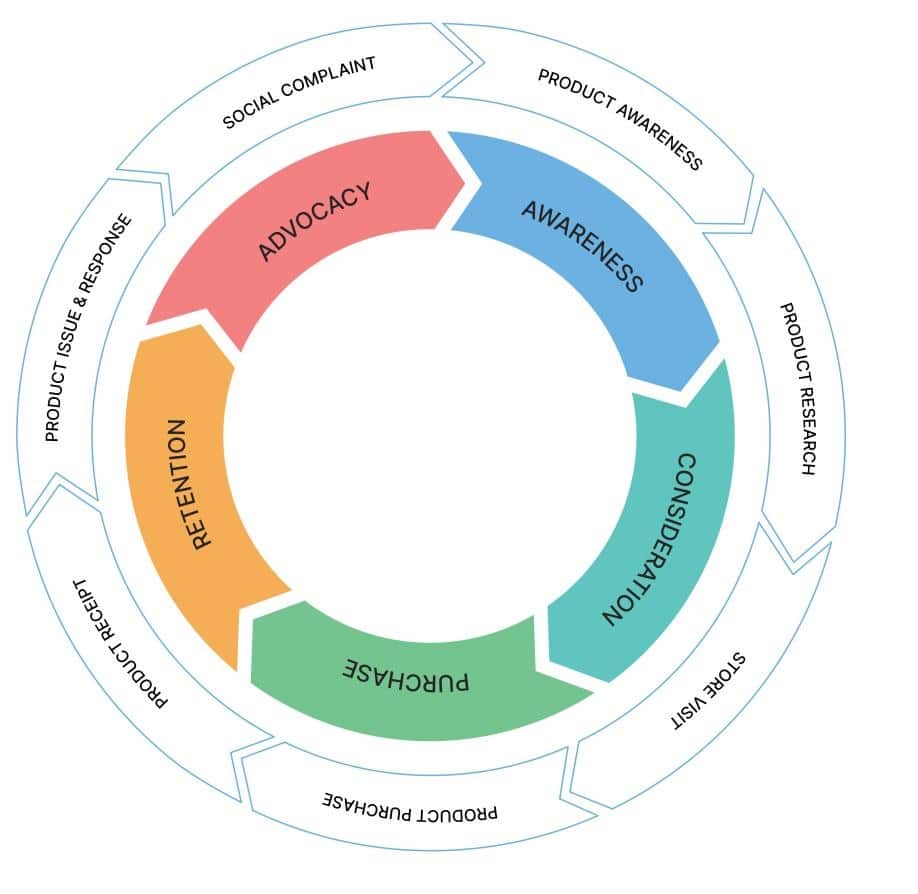
Awareness
Awareness involves spreading awareness about your products and services. Customers search for different products and services at this stage. It is the right time to shine and attract customers through your sales funnel.
Consideration
Customers are directly interacting with your brand at this stage. However, they are also searching for better alternatives. Thus, it is a crucial stage where you must convince customers that your products are superior to others.
Conversion
This is a make-or-break stage in the customer journey. Customers now decide whether they want to take action on your products and services. They decide whether your solutions are better than other available alternatives. For this stage, you need a clear call to action button so that customers will not think twice before taking action.
Retention
You already have a customer at this point. This stage is, therefore, focused on retaining your customers. That is because a study shows that a 5% increase in customer retention can lead to a 25% to 95% increase in profit. Customer retention involves excellent after-sales services.
Advocacy
Do you know 97% of consumers depend upon online reviews to make a purchase decision? That is why you must motivate your satisfied and happy customers to leave good reviews for your business. This is what the final stage in the customer journey is all about! Customer advocacy will help you acquire more customers and touch their journey at a personal level.
Thus, it is evident that a customer moves through different stages before buying. Analyzing the customer journey can help you produce accurate content and promote your business on the right marketing channels.
However, the first step in tracking your customer journey is to create a buyer persona. This can help you categorize your customers into different groups and keep a close eye on their journey. It can also enable you to create a customer journey map to analyze your individual customer’s journey visually.
What is a Customer Journey Map?
A customer journey map is a visual tool that helps businesses understand and improve the entire customer experience. It details each step of the customer’s interactions with a brand, from initial contact to post-purchase engagement. Outlining this journey can help businesses identify challenges, positive experiences, and areas for improvement, aligning their operations with customer needs and expectations.
Customer journey mapping helps you:
- Reveal customer pain points and optimizing marketing touchpoints
- Promote team communication and collaboration
- Drive customer loyalty and retention
- Provide the brand with a competitive edge in the market
- Guide continuous improvements through data-driven decisions
What is a Customer Experience?
Customer experience is a customer’s perception of your company after interacting with different aspects of your products and services. It is an amalgamation of the entire customer journey. In short, it is how a customer feels about your brand.
Usually, customer experience revolves around two things—products and people. If your product and the buying process are excellent, it can improve user experience. On a similar note, if your customer support team provides fantastic services, it can reflect on the customer experience. So, there are limited means to improve customer experience. However, with user behavior analytics, you can gain insights to enhance your customer experience.
What is a Customer Experience Map?
A customer experience map, or CX map, is a visual tool that outlines the customer’s experience with a brand.
Think of it as a storyboard that captures the peaks and valleys of the customer’s interactions. This map helps businesses understand customer perceptions of their brand and identify areas for improvement to enhance the overall experience.
Key benefits of a customer experience map include:
- Uncovers funnel bottlenecks preventing customers from buying from your brand
- Addresses gaps in the customer journey to boost satisfaction
- Identifies inefficiencies in the sales cycle to rectify them for enhanced efficiency
- Provides insights for strategic planning and informed decision-making
- Promotes better cross-functional collaboration between marketing and sales
Customer Journey vs. Customer Experience: What is the Difference?
Now that you have learned about both customer journeys and experiences separately, you must wonder how they differ when both focus on customers.
In essence, customer journeys and customer experiences are closely tied. They are parts of the same process that helps to convert potential leads into paying customers.
However, the customer journey is a strategy that improves customer experience. Through customer journey mapping, you can understand different touchpoints of customers with your business. As a result, it helps you improve customer experience and generate more leads.
Let’s draw an example to clear your confusion once and for all.
Suppose you are a loyal customer of a local taco restaurant. You love the taste of their tacos, and never miss a chance to recommend this restaurant to your friends. Unfortunately, you do not like their customer service. The waiters are super rude, and it takes ages to get food out of the kitchen.
As exemplified above, products and people make the experience. In this case, the product is excellent, but people are not. This means that there is a faulty part in the customer’s buying journey. This revelation can help the restaurant to improve customer experience and prevent a loyal customer from going anywhere else.
This also means that despite some differences, customer journey and customer experience are two extremely important parts of customer retention and acquisition. Thus, you need to track them both to boost your sales. To understand the basic differences between customer journeys and customer experiences, take a look at the table below.
| Criteria | Customer Journey | Customer Experience |
| Scope | Encompasses the entire process a customer goes through when interacting with a brand, from initial awareness to post-purchase support. | Focuses on the customer’s experience with the brand, it’s products and services. |
| Objective | Aims to map out and understand the full path a customer takes, identifying key touchpoints and potential friction points. | Focuses on optimizing each interaction to ensure it is positive and meets customer expectations. |
| Control | Managed by analyzing overall paths and flow across multiple channels and stages. | Controlled at individual touchpoints, such as customer service interactions, website usability, and product quality. |
| Measurement | Measured using metrics like conversion rates, drop-off points, and time spent at each stage. | Evaluated through customer satisfaction scores, Net Promoter Score (NPS), and feedback on specific interactions. |
| Improvement Focus | Focuses on removing obstacles and smoothing transitions between stages to create a seamless overall path. | Aims to enhance the quality and satisfaction of each specific interaction, ensuring consistency and delight. |
| Desired Outcome | Seeks to create an efficient, cohesive journey that leads to conversions and repeat business. | Aims to build positive impressions and emotional connections, resulting in customer loyalty and advocacy. |
How Does Customer Journey Tracking Help Me?
Tracking and analyzing customer journeys helps you understand how customers engage with your product and marketing both before and after the purchase happens. It helps you:
- Understand product and service usage.
- Track buyer intent to know when leads are ready for the next step.
- Identify campaigns that generate more revenue and eliminate low-performing strategies.
- Segment leads/customers/users and score leads based on how they engage through the customer journey.
- Track live chat and webform submissions and their influence on the customer journey.
- Understand how specific pages and content pieces influence visitors and Identify problems in the funnel.
How Does Customer Experience Tracking Help Me?
Tracking and enhancing customer experience can significantly improve your acquisition and retention.
It helps you:
- Improve the experience of buyers throughout the funnel and have positive experiences.
- Retain existing customers by providing good experiences.
- Get referrals from happy customers.
- Upsell to existing customers and avoid bad reviews.
3 Best Customer Journey Tracking Tools
To map your customer journey in real-time, you use the following customer journey trackers:
1. Salespanel
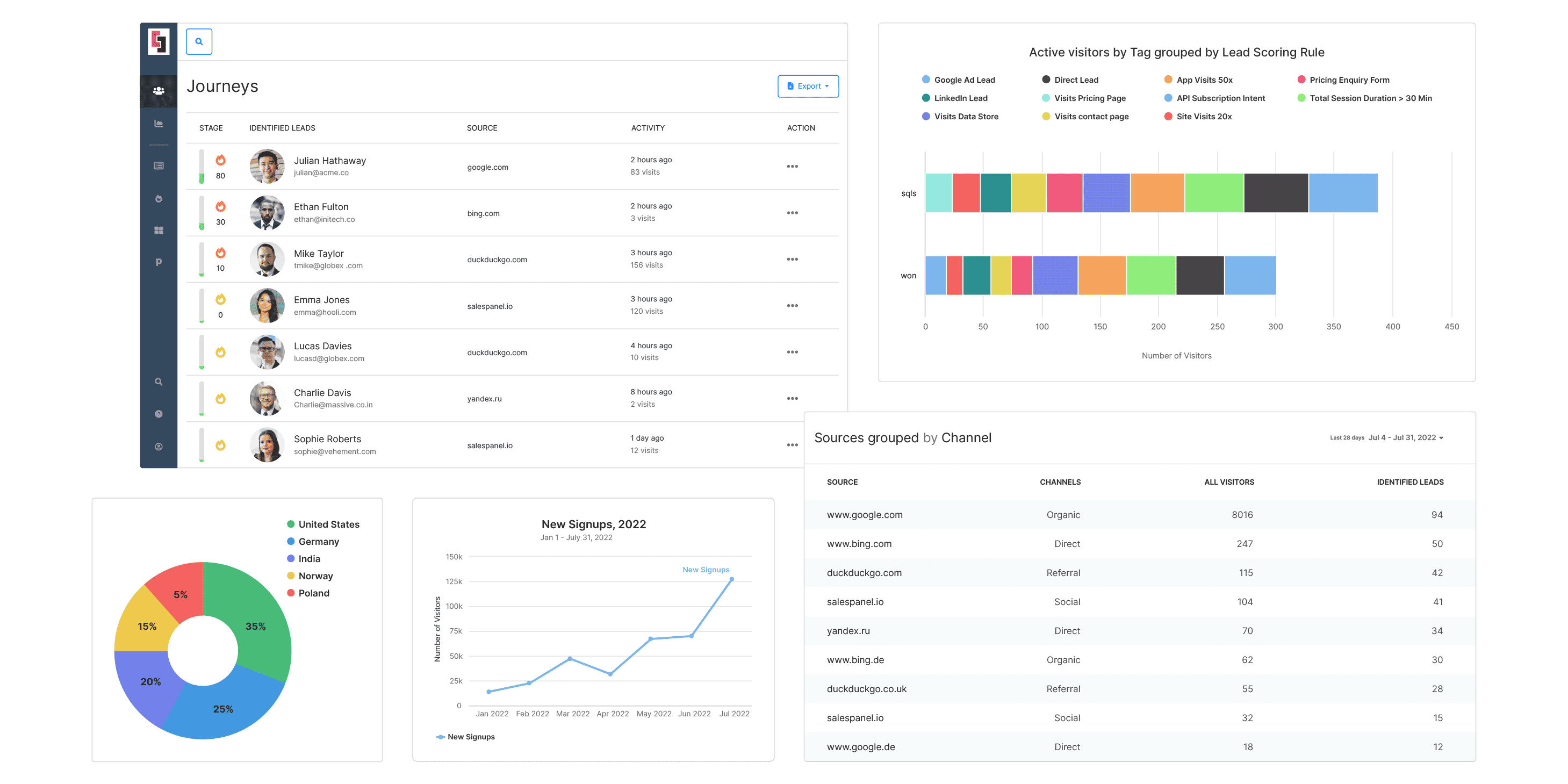
Salespanel is a good customer journey tracking solution for B2B businesses. This software tracks your customers’ journey across your content and website elements. It provides analytical data to improve customer experience with personalized solutions.
You can also track custom website events and product elements to understand how your customers engage with your services. This will help you gain proactive control over the customer journey, enhance your customers’ experience, and close more qualified deals.
Salespanel allows you to track all website elements to take real-time actions to convert leads. With our analytical engine and actionable data, you can also learn which campaigns are leading to MQLs, SQLs, and customers. Overall, it is one of the best tools in the market to get a grip on the customer journey.
2. Woopra
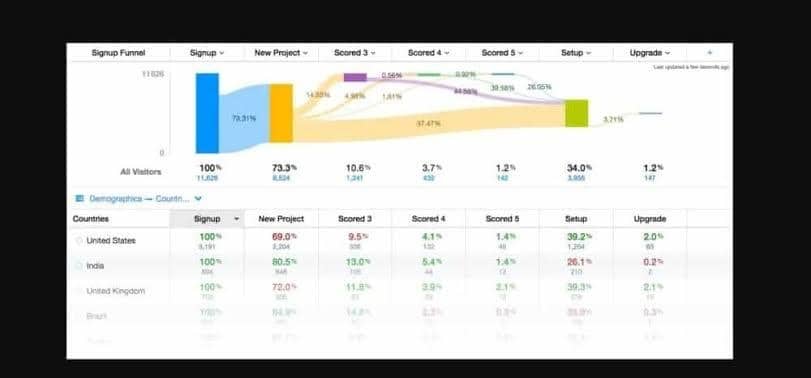
Image Source: predictiveanalyticstoday.com
Woopra is a customer journey analytics solution that is changing how businesses understand, analyze, engage, and retain customers. The platform supports optimization and growth across the entire customer lifecycle. In addition to this, Woopra uses individual-level data to generate aggregate analytics reports that bridge all departmental gaps.
Woopra’s proprietary tracking technology monitors user behavior across your website, product, and mobile applications. Furthermore, the platform provides 51+ one-click integrations with partners such as Salesforce, Marketo, Intercom, and Segment to unify disparate data points across tools and teams.
3. Adobe Customer Journey Analytics
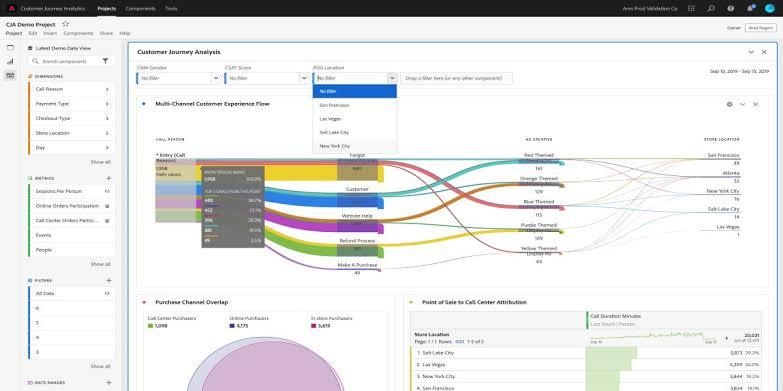
Image Source: venturebeat.com
Adobe Customer Journey Analytics is a service built on the Adobe Experience Platform. It allows users to combine data from all channels into a single interface for real-time, omnichannel analysis and visualization.
Furthermore, users can make better decisions with a holistic view of the business and the context behind every customer action.
The Experience Platform allows users to connect and standardize data from any online or offline source for non-destructive querying, analysis, and modeling. You can also improve segmentation, obtain objective attribution, and comprehend the factors influencing anomalies from data across channels, with artificial intelligence (AI).
3 Best Customer Experience Tracking Tools
Now, let’s next check out the best tools to track and analyze your customer experience across platforms.
1. Hotjar
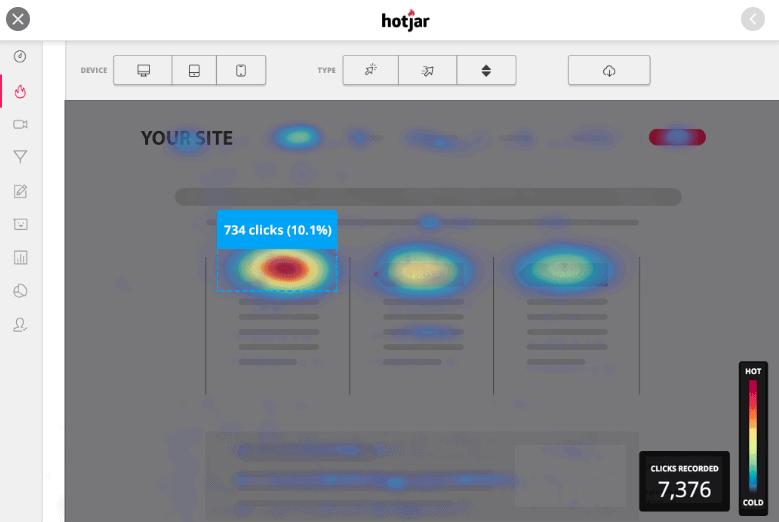
Image Source: billmark.com
Hotjar is a good conversion rate optimization and customer journey analysis tool. Its main features are heat mapping, visual session recording, conversion funnel analytics, form analytics, feedback polls and surveys, and usability testing.
With Hotjar, you also get the exceptional benefit of live recording your users’ interactions with your website. Furthermore, Hotjar provides real-time embedding tools for feedback to obtain filtered responses on particular pages of your website.
It is the best for digital analysts, UX designers, web developers, and product marketers.
2. VWO
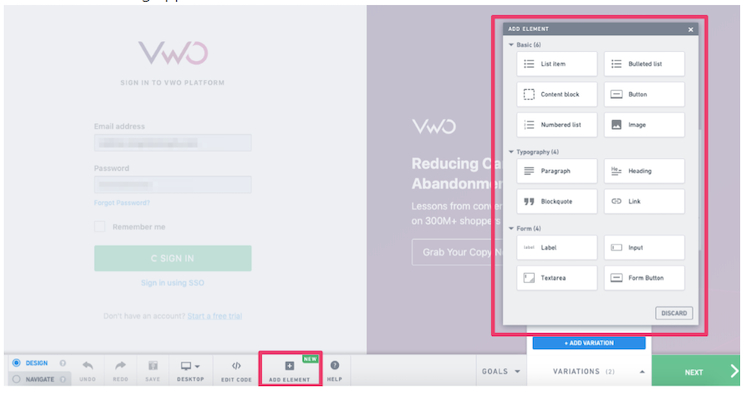
Image Source: getapp.com
VWO is a split testing and conversion optimization tool for growing businesses. It allows them to conduct qualitative and quantitative visitor research, create an experimentation roadmap, and run continuous experiments on their digital properties.
Anothher innovative feature of this software is its heatmaps. Users can customize segments to look into individual page drop-offs or slice and dice data based on basic segments like traffic source and device using the segmentation options in the heatmap report. This feature helps in the thorough analysis of visitor behavior data, offering insightful information for optimization.
Besides heatmaps, VWO enables businesses to understand on-site visitor behavior through heatmaps, surveys, and visitor recordings. In addition, VWO enables research-driven A/B testing to optimize web experience across desktop, mobile, and other devices to deliver a unique experience based on visitor preferences.
3. Heap
Heap analyses datasets to uncover hidden insights within the user’s digital journey, allowing them to act confidently. It is a unique digital analytics platform that automatically records, examines, and produces actionable information from consumer interactions to enhance customer experience, retention, and conversions.
Heap tracks user activity on mobile apps and websites, allowing businesses to examine consumer behavior and produce data-based insights.
Heap has several functionalities, including real-time reporting, automatic event tracking, and retroactive data collection. To facilitate the identification of trends and patterns, Heap also enables businesses to segment their data based on users, sessions, and events.
Customer Journey vs. Customer Experience: Which Matters the Most?
Both!
Both customer journey and customer experience tracking are crucial to boosting sales and retaining customers. A customer journey is a path that leads to improving customer experience. Without customer journey mapping, CX is not possible.
Thus, you need to track both aspects to create a proper sales funnel for your customers. For that, you can use powerful tools like Salespanel to help you understand and analyze the data from different angles. Get in touch with us if you wish to learn more!
Sell more, understand your customers’ journey for free!
Sales and Marketing teams spend millions of dollars to bring visitors to your website. But do you track your customer’s journey? Do you know who buys and why?
Around 8% of your website traffic will sign up on your lead forms. What happens to the other 92% of your traffic? Can you identify your visiting accounts? Can you engage and retarget your qualified visitors even if they are not identified?


